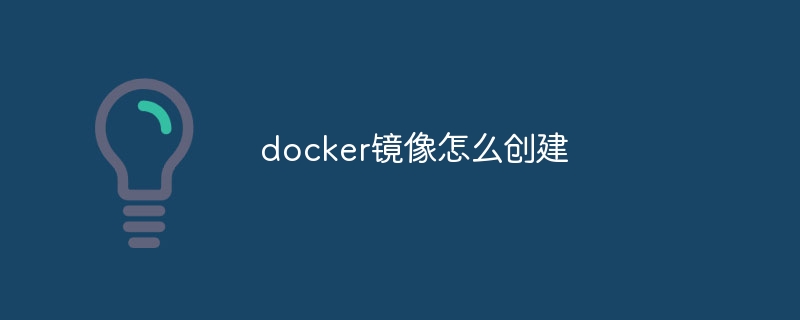How to create a docker image
How to create a Docker image? Create a Dockerfile, specifying the instructions required to build the image; build the image with docker build; add a tag to the image with docker tag; (Optional) Use docker push to push the image to the registry.

Docker image creation guide
How to create a Docker image?
Creating a Docker image involves the following steps:
1. Create a Dockerfile
A Dockerfile is a text file that contains instructions for building images. It specifies the basic image to use, the packages installed, and other configurations required for the image runtime.
2. Build a mirror
Use the docker build command to build the image. This command will create an image based on the directives in the Dockerfile.
3. Mark the mirror
Mark the mirror so that it can be identified. Tags contain the image name and version or label.
4. Push mirror (optional)
If you need to use the image on other machines, you can push it to the Docker registry.
Detailed steps:
1. Create a Dockerfile
<code>FROM ubuntu:latest RUN apt-get update && apt-get install -y nginx</code>
This will create a basic image based on the latest version of Ubuntu and install an Nginx web server.
2. Build a mirror
In the directory containing the Dockerfile, run the following command:
<code>docker build -t my-nginx-image .</code>
This will build an image named "my-nginx-image" based on the Dockerfile.
3. Mark the mirror
Use the following command to mark the image:
<code>docker tag my-nginx-image my-nginx-image:v1</code>
This creates a "my-nginx-image" image with the tag "v1".
4. Push mirror (optional)
To push the image to the registry, use the following command:
<code>docker push my-nginx-image:v1</code>
This pushes the image to a registry named "my-nginx-image", with the tag "v1".
The above is the detailed content of How to create a docker image. For more information, please follow other related articles on the PHP Chinese website!

Hot AI Tools

Undresser.AI Undress
AI-powered app for creating realistic nude photos

AI Clothes Remover
Online AI tool for removing clothes from photos.

Undress AI Tool
Undress images for free

Clothoff.io
AI clothes remover

Video Face Swap
Swap faces in any video effortlessly with our completely free AI face swap tool!

Hot Article

Hot Tools

Notepad++7.3.1
Easy-to-use and free code editor

SublimeText3 Chinese version
Chinese version, very easy to use

Zend Studio 13.0.1
Powerful PHP integrated development environment

Dreamweaver CS6
Visual web development tools

SublimeText3 Mac version
God-level code editing software (SublimeText3)

Hot Topics
 How to exit the container by docker
Apr 15, 2025 pm 12:15 PM
How to exit the container by docker
Apr 15, 2025 pm 12:15 PM
Four ways to exit Docker container: Use Ctrl D in the container terminal Enter exit command in the container terminal Use docker stop <container_name> Command Use docker kill <container_name> command in the host terminal (force exit)
 How to copy files in docker to outside
Apr 15, 2025 pm 12:12 PM
How to copy files in docker to outside
Apr 15, 2025 pm 12:12 PM
Methods for copying files to external hosts in Docker: Use the docker cp command: Execute docker cp [Options] <Container Path> <Host Path>. Using data volumes: Create a directory on the host, and use the -v parameter to mount the directory into the container when creating the container to achieve bidirectional file synchronization.
 How to check the name of the docker container
Apr 15, 2025 pm 12:21 PM
How to check the name of the docker container
Apr 15, 2025 pm 12:21 PM
You can query the Docker container name by following the steps: List all containers (docker ps). Filter the container list (using the grep command). Gets the container name (located in the "NAMES" column).
 How to restart docker
Apr 15, 2025 pm 12:06 PM
How to restart docker
Apr 15, 2025 pm 12:06 PM
How to restart the Docker container: get the container ID (docker ps); stop the container (docker stop <container_id>); start the container (docker start <container_id>); verify that the restart is successful (docker ps). Other methods: Docker Compose (docker-compose restart) or Docker API (see Docker documentation).
 How to start mysql by docker
Apr 15, 2025 pm 12:09 PM
How to start mysql by docker
Apr 15, 2025 pm 12:09 PM
The process of starting MySQL in Docker consists of the following steps: Pull the MySQL image to create and start the container, set the root user password, and map the port verification connection Create the database and the user grants all permissions to the database
 How to update the image of docker
Apr 15, 2025 pm 12:03 PM
How to update the image of docker
Apr 15, 2025 pm 12:03 PM
The steps to update a Docker image are as follows: Pull the latest image tag New image Delete the old image for a specific tag (optional) Restart the container (if needed)
 How to create containers for docker
Apr 15, 2025 pm 12:18 PM
How to create containers for docker
Apr 15, 2025 pm 12:18 PM
Create a container in Docker: 1. Pull the image: docker pull [mirror name] 2. Create a container: docker run [Options] [mirror name] [Command] 3. Start the container: docker start [Container name]
 How to view the docker process
Apr 15, 2025 am 11:48 AM
How to view the docker process
Apr 15, 2025 am 11:48 AM
Docker process viewing method: 1. Docker CLI command: docker ps; 2. Systemd CLI command: systemctl status docker; 3. Docker Compose CLI command: docker-compose ps; 4. Process Explorer (Windows); 5. /proc directory (Linux).






